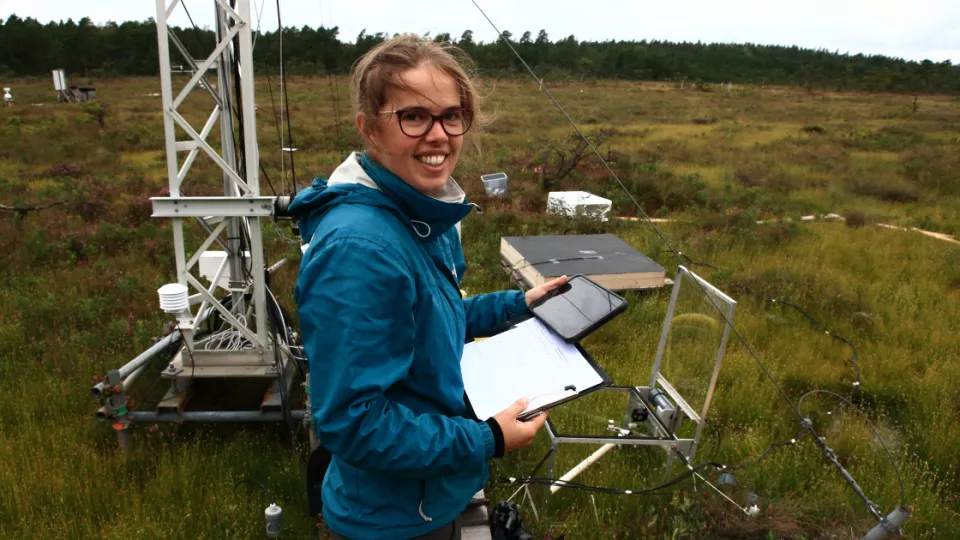Boreal forests and peatlands are a globally important carbon sink, currently storing at least a fifth of all the carbon contained in terrestrial ecosystems. However, rising air temperature and changes in precipitation and the frequency of natural disturbances will all have an effect on the movement of carbon between these ecosystems and the atmosphere. Higher air temperature for example may prolong the growing season which allows carbon to be captured by plants over a longer time, but it may also stimulate the decomposition of organic matter in the soil, which releases carbon dioxide, CO2.
In her recently presented doctoral dissertation, Julia Kelly has studied the relationship between high temperatures and CO2 emissions from vegetation and soil in peatlands in Sweden and Finland. To do this she used thermal cameras placed on drones as well as satellite data.
"Thermal cameras take images of temperature, which we know is an important biological variable that affects CO2 emissions. By using these cameras we can map temperature and emissions in areas that do not have measuring stations and in greater detail than can be measured on the ground", says Julia Kelly.
The high resolution data collected from the thermal cameras was then used to analyse the effects of temperature and other variables on the carbon fluxes. The data could also distinguish variations in micro topography and vegetation, which was important, as the amount of carbon emitted varied greatly with vegetation composition. If this isn’t taken into account, CO2 emissions from peatlands could be over- or underestimated by up to 18 percent, according to Julia Kelly.
Besides investigating how the high resolution data from the drones could be used to understand the effects of spatial variation on carbon fluxes within a peatland, she also investigated how extreme heat impacts carbon exchange. Data was collected from the drought year of 2018 which was one of the warmest and driest years ever recorded in Sweden. Peatlands are particularly vulnerable to drought because they are dependent on maintaining waterlogged conditions to slow the decomposition of their dense carbon stocks. Warmer temperatures and dry conditions are thus expected to have a large impact on their carbon emissions. This assumption turned out to be correct - with a few exceptions.
"We found that some peatlands during the drought released much less carbon than expected. The extreme lack of water reduces the ability to decompose organic matter in the soil, which lowered the CO2 emissions. This is interesting because we normally think that climate change will cause peatlands
to emit more greenhouse CO2, not less."
According to Julia Kelly the key factor is limited water access. Carbon exchange is closely tied to the severity of the disturbance, and since the drought in 2018 was so extreme, CO2 emissions in some peatlands decreased. During less severe droughts however, emissions normally increase since the peat is neither too dry or too wet - the perfect conditions for decomposition by soil microbes and plant growth, which both releases CO2. She also found that the drought caused peatlands to store less carbon because of declines in photosynthesis.
In her last paper Julia Kelly quantified the effects of the largest Swedish wildfire in 2018 on forest soils, including how it affected the exchange of different greenhouse gases, soil microclimate and chemistry at five different sites. When examining the impacts of salvage logging after the fire, she did not observe any differences between the sites where the trees had been cut down after the fire compared to where the trees had been left standing. She also compared forests of different ages (10 and 100 years).
"This time we saw big differences in the carbon fluxes from the soil, soil temperature and soil water content. The young site had been clear cut only 12 years earlier and when forests are affected by several disturbances it lowers their ability to recover. For example, the forests lose their ability to accumulate carbon in the soil, which is important as these boreal ecosystems account for 20 percent of the carbon stored by the terrestrial ecosystems globally."
She hopes that her thesis will contribute to environmental science in two ways: by consolidating our understanding of the factors driving carbon exchange in boreal ecosystems and by developing new methods to model and upscale peatland CO2 fluxes. As part of this work she developed guidelines to help users of thermal cameras and drones collect the most accurate data possible.
"I hope that scientists will find these best practices for drones and thermal cameras useful. Temperature is such an important variable and I believe it will become more and more common to use thermal cameras."


